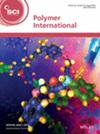下载PDF
{"title":"TiO2-doped sulfonated poly(etheretherketone)/poly(vinyl alcohol) blend membrane synthesis for microbial fuel cell systems","authors":"Sema Tuğçe Baykara, Gizem Hazan Akçay, Aygün Çalı, İrfan Ar","doi":"10.1002/pi.6786","DOIUrl":null,"url":null,"abstract":"<p>This study explores the development and comprehensive evaluation of titanium dioxide (TiO<sub>2</sub>)-doped, thermally crosslinked sulfonated poly(ether ether ketone) (SPEEK)/poly(vinyl alcohol) (PVA) blend membranes for microbial fuel cell (MFC) applications. The membranes were synthesized with varying TiO<sub>2</sub> concentrations and characterized through analyses of water content, ion exchange capacity, swelling behavior, mechanical strength, electrochemical impedance spectroscopy and Fourier transform infrared spectroscopy. Incorporation of TiO<sub>2</sub> significantly enhanced proton conductivity and reduced water-induced mass loss compared to undoped membranes. Among the various compositions, the membrane containing 5 wt% TiO<sub>2</sub> (SPEEK/PVA-5T) demonstrated the highest proton conductivity of 0.4346 S cm<sup>−1</sup> at 25 °C, indicating superior performance. The membranes were tested in a cylindrical H-type MFC setup. The SPEEK/PVA-5T membrane achieved a maximum voltage output of 560.610 mV and a power density of 62.856 μW m<sup>−2</sup>, in comparison to a commercial Nafion 117 membrane, which delivered 777.740 mV and 120.975 μW m<sup>−2</sup>. These findings underscore the potential of the SPEEK/PVA-5T membrane as an effective and sustainable alternative for MFC applications, offering enhanced ion transport and contributing to the advancement of carbon-neutral energy technologies. This work represents a meaningful step toward the development of high-performance, eco-friendly membrane materials for renewable energy systems. © 2025 The Author(s). <i>Polymer International</i> published by John Wiley & Sons Ltd on behalf of Society of Chemical Industry.</p>","PeriodicalId":20404,"journal":{"name":"Polymer International","volume":"74 9","pages":"848-857"},"PeriodicalIF":3.6000,"publicationDate":"2025-05-30","publicationTypes":"Journal Article","fieldsOfStudy":null,"isOpenAccess":false,"openAccessPdf":"https://scijournals.onlinelibrary.wiley.com/doi/epdf/10.1002/pi.6786","citationCount":"0","resultStr":null,"platform":"Semanticscholar","paperid":null,"PeriodicalName":"Polymer International","FirstCategoryId":"92","ListUrlMain":"https://scijournals.onlinelibrary.wiley.com/doi/10.1002/pi.6786","RegionNum":4,"RegionCategory":"化学","ArticlePicture":[],"TitleCN":null,"AbstractTextCN":null,"PMCID":null,"EPubDate":"","PubModel":"","JCR":"Q2","JCRName":"POLYMER SCIENCE","Score":null,"Total":0}
引用次数: 0
引用
批量引用
Abstract
This study explores the development and comprehensive evaluation of titanium dioxide (TiO2 )-doped, thermally crosslinked sulfonated poly(ether ether ketone) (SPEEK)/poly(vinyl alcohol) (PVA) blend membranes for microbial fuel cell (MFC) applications. The membranes were synthesized with varying TiO2 concentrations and characterized through analyses of water content, ion exchange capacity, swelling behavior, mechanical strength, electrochemical impedance spectroscopy and Fourier transform infrared spectroscopy. Incorporation of TiO2 significantly enhanced proton conductivity and reduced water-induced mass loss compared to undoped membranes. Among the various compositions, the membrane containing 5 wt% TiO2 (SPEEK/PVA-5T) demonstrated the highest proton conductivity of 0.4346 S cm−1 at 25 °C, indicating superior performance. The membranes were tested in a cylindrical H-type MFC setup. The SPEEK/PVA-5T membrane achieved a maximum voltage output of 560.610 mV and a power density of 62.856 μW m−2 , in comparison to a commercial Nafion 117 membrane, which delivered 777.740 mV and 120.975 μW m−2 . These findings underscore the potential of the SPEEK/PVA-5T membrane as an effective and sustainable alternative for MFC applications, offering enhanced ion transport and contributing to the advancement of carbon-neutral energy technologies. This work represents a meaningful step toward the development of high-performance, eco-friendly membrane materials for renewable energy systems. © 2025 The Author(s). Polymer International published by John Wiley & Sons Ltd on behalf of Society of Chemical Industry.
用于微生物燃料电池系统的tio2掺杂磺化聚醚酮/聚乙烯醇共混膜合成
本研究探讨了二氧化钛(TiO2)掺杂、热交联磺化聚醚醚酮(SPEEK)/聚乙烯醇(PVA)共混膜在微生物燃料电池(MFC)应用中的发展和综合评价。合成了不同TiO2浓度的膜,并通过水含量、离子交换容量、溶胀行为、机械强度、电化学阻抗谱和傅里叶变换红外光谱分析对膜进行了表征。与未掺杂的膜相比,TiO2的掺入显著提高了质子电导率,减少了水引起的质量损失。在各种组合物中,含有5 wt% TiO2 (SPEEK/PVA-5T)的膜在25°C时的质子电导率最高,为0.4346 S cm−1,显示出优越的性能。在圆柱形h型MFC装置中对膜进行了测试。SPEEK/PVA-5T膜的最大输出电压为560.610 mV,功率密度为62.856 μW m−2,而商用Nafion 117膜的输出电压为777.740 mV,功率密度为120.975 μW m−2。这些发现强调了SPEEK/PVA-5T膜作为MFC应用的有效和可持续替代方案的潜力,提供增强的离子传输并促进碳中和能源技术的发展。这项工作代表了为可再生能源系统开发高性能、环保膜材料的重要一步。©2025作者。聚合物国际出版的约翰威利&;我代表化学工业协会的儿子有限公司。
本文章由计算机程序翻译,如有差异,请以英文原文为准。




 求助内容:
求助内容: 应助结果提醒方式:
应助结果提醒方式:


